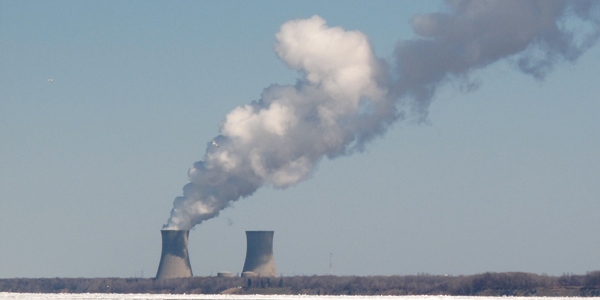By Rory D. Sweeney
After reporting a loss of $6.2 billion ($14.49/share) for 2016, FirstEnergy’s CEO said the company plans to seek subsidies for its Davis-Besse and Perry nuclear plants in Ohio to make them attractive to buyers and allow the company to exit competitive generation in 2018.
“I can’t speak for prospective new owners of these four nuclear units, but I can tell you this: Running nuclear reactors isn’t something that just anybody can do. And there is a significant amount of capital risk associated with that business,” CEO Charles E. Jones said in response to analysts’ questions during an earnings call Wednesday. “I’m not sure people are going to be willing to take on the risk of even the next refueling outage, which is very expensive, so I don’t think there’s any guarantee — absent some other support for these units — that they’re going to keep running far into the future.”
The “support” would be zero-emissions credits, which have been approved for nuclear power plants in Illinois and New York but face challenges in federal court.
FirstEnergy’s multibillion-dollar loss for 2016, which came on revenue of $14.6 billion, includes asset impairment and plant exit costs related to its decision to leave competitive generation by mid-2018. The company reported earnings of $578 million ($1.37/share) in 2015 on revenue of $15 billion.
For the fourth quarter, FirstEnergy posted a loss of $5.8 billion ($13.44/share) on revenue of $3.4 billion versus a loss of $226 million ($0.53/share) on revenue of $3.5 billion a year earlier. Higher corporate operating expenses and increased retirement costs factored into the loss, but it was partially offset by reductions in the valuation of pension and post-employment benefits.
The company’s adjusted earnings were $2.63/share for 2016 compared to $2.71/share for 2015 and 38 cents/share for the fourth quarter compared to 58 cents/share a year ago.
Jones said the company’s generation fleet will go into bankruptcy without a buyer, and a buyer is unlikely without more financial certainty for the nuclear assets.
“These assets are now valued at somewhere around $1.5 billion and that includes the nuclear fuel that they own. The debt is significantly higher than that. … It’s highly unlikely that we’ll get the book value to a place that’s greater than the debt. … Absent something to raise the value of these units and make them attractive to a buyer, there’s only one way for us to exit this business,” he said. “I’ve been up front with the legislators that I have met with, personally, to tell them, ‘Don’t do this [approve ZECs] for FirstEnergy because it’s unlikely we’re going to be the long-term owner-operators of these assets.’”
PJM has remained agnostic about state actions but active in figuring out ways to address them.
“Our position is not whether a state should or shouldn’t do whatever it is they want to do, but [what] we have to think about is how do we make sure the market remains competitive. … We need to protect the integrity of the regional market price,” PJM CEO Andy Ott said in an interview with The Plain Dealer, Cleveland’s major daily newspaper. “We have to figure out a way to harmonize what is happening in wholesale markets and what is happening at the state level.”
Last month, RTO stakeholders approved the creation of the Capacity Construct/Public Policy Senior Task Force to consider how to ensure that PJM’s markets don’t run afoul of state initiatives. Its first meeting is on March 6. (See PJM to Review Impact of State Public Policies on RPM.)
He also noted that the company has restructured its finances in preparation for a potential return to cost-of-service regulation in Ohio.
“We successfully restructured our credit facilities to provide the necessary financial flexibility to become a fully regulated company,” he said.
On the regulated utility side, distribution deliveries increased 4% in the fourth quarter. Weather-related usage resulted in an 8% increase in residential sales compared to the prior-year period, while commercial sales increased 3% because of a combination of weather and stronger demand. Heating degree days in the fourth quarter were 8.9% below normal but 26.3% higher than the same period of 2015. Deliveries to industrial customers increased nearly 2%, primarily because of higher usage in the shale gas and steel sectors.
The regulated transmission business increased because of a higher rate base associated with its Energizing the Future infrastructure program. Earnings were flat year over year, reflecting an increase in rate base offset by a lower return on equity at its electric transmission subsidiary, American Transmission Systems Inc., as part of its comprehensive formula rate settlement.
In its competitive generation business, its commodity margin was down compared to 2015 from lower capacity revenues and contract sales volume, though it was partially offset by higher wholesale sales and lower capacity and fuel expenses.



